Curing Effect on Durability of Cement Mortar with GGBS: Experimental and Numerical Study
Abstract
:1. Introduction
2. Materials and Method
2.1. Samples
2.2. Curing and Drying
- Standard curing: samples were at C and a relative humidity (R.H.) ≥ 90%.
- Dry curing: samples were at C and R.H. < 50%.
- Cold curing: samples were at C and R.H. ≥ 90%.
2.3. Measuring Porosity and Gas Permeability
2.4. Measuring Water Absorption
3. Modeling Approach
3.1. Mathematical Flow Model
3.2. Bayesian Inference
3.3. MCMC Sampling Procedure
| Algorithm 1 Metropolis-Hastings algorithm. |
|
4. Results and Discussion
4.1. Influence of Curing Conditions and GGBS Proportions on the Porosity
4.2. Influence of Curing Conditions and GGBS Proportions on the Permeability
4.3. Influence of Curing Conditions and GGBS Proportions on the Water Absorption
4.4. Forward and Inverse Modeling
4.5. Analysis of the MCMC Estimates
5. Conclusions
- Among the selected curing conditions, the performance of the standard curing condition is better than that of other curing conditions. Minimum porosity, intrinsic permeability, and water absorption were measured in samples cured in standard conditions, while maximum values were found in samples cured in dry conditions.
- Samples containing of GGBS cured in standard condition slightly enhanced the porosity by as compared to the reference sample. The porosity variation between the cold and standard cures was not that significant. On the other hand, the dry-cured samples didn’t show any improvement, whatever the replacement level of GGBS. Porosity values increased with an increase in GGBS content.
- The permeability was improved by with the inclusion of of GGBS in the standard curing samples. All other samples presented higher permeability values compared to the reference sample. Cold curing samples showed a significant decrease in permeability values with an increase in GGBS replacement, while the opposite tendency was observed for dry curing samples.
- In terms of water absorption, maximum improvement of was found in samples cured in standard condition with of GGBS. With a further increase in GGBS replacement, standard curing samples exhibited almost a similar water absorption to that of the reference sample. For cold-curing samples with of GGBS, we also observed a little improvement of . Beyond , a slight drop in water absorption resistance was noticed. Ultimately, dry curing samples revealed a significant increase in water absorption with an increase in GGBS content.
- Numerical inverse modeling showed a good agreement between measured and estimated intrinsic permeability. Moreover, the simulated cumulative weights of the samples over time fitted well with those measured. The corresponding average RMSE is around . Such promising results demonstrate the capability of the proposed inference approach to accurately predict the hydraulic parameters of the samples from extremely short capillary suction experiments and simulate water flow through mortar samples.
Author Contributions
Funding
Institutional Review Board Statement
Informed Consent Statement
Data Availability Statement
Conflicts of Interest
References
- Monteiro, P.J.; Miller, S.A.; Horvath, A. Towards sustainable concrete. Nat. Mater. 2017, 16, 698–699. [Google Scholar] [CrossRef] [PubMed]
- Chen, C.; Habert, G.; Bouzidi, Y.; Jullien, A. Environmental impact of cement production: Detail of the different processes and cement plant variability evaluation. J. Clean. Prod. 2010, 18, 478–485. [Google Scholar] [CrossRef]
- Andrew, R.M. Global CO2 emissions from cement production. Earth Syst. Sci. Data 2018, 10, 195–217. [Google Scholar] [CrossRef] [Green Version]
- Crossin, E. The greenhouse gas implications of using ground granulated blast furnace slag as a cement substitute. J. Clean. Prod. 2015, 95, 101–108. [Google Scholar] [CrossRef]
- Siddique, R. Utilization (recycling) of iron and steel industry by-product (GGBS) in concrete: Strength and durability properties. J. Mater. Cycles Waste 2014, 16, 460–467. [Google Scholar] [CrossRef]
- Johari, M.M.; Brooks, J.; Kabir, S.; Rivard, P. Influence of supplementary cementitious materials on engineering properties of high strength concrete. Constr. Build. Mater. 2011, 25, 2639–2648. [Google Scholar] [CrossRef]
- Ahmad, J.; Martínez-García, R.; Szelag, M.; de Prado-Gil, J.; Marzouki, R.; Alqurashi, M.; Hussein, E.E. Effects of Steel Fibers (SF) and Ground Granulated Blast Furnace Slag (GGBS) on Recycled Aggregate Concrete. Materials 2021, 14, 7497. [Google Scholar] [CrossRef] [PubMed]
- Uysal, M.; Sumer, M. Performance of self-compacting concrete containing different mineral admixtures. Constr. Build. Mater. 2011, 25, 4112–4120. [Google Scholar] [CrossRef]
- Teng, S.; Lim, T.Y.D.; Divsholi, B.S. Durability and mechanical properties of high strength concrete incorporating ultra fine ground granulated blast-furnace slag. Constr. Build. Mater. 2013, 40, 875–881. [Google Scholar] [CrossRef]
- Liu, S.; Zhu, M.; Ding, X.; Ren, Z.; Zhao, S.; Zhao, M.; Dang, J. High-durability concrete with supplementary cementitious admixtures used in corrosive environments. Crystals 2021, 11, 196. [Google Scholar] [CrossRef]
- Kumar, G.V.; Kumar, B.N. Effect on mechanical, durability and micro structural properties of high strength self compacting concrete with inclusion of micro and nano silica. Mater. Today Proc. 2022, 60, 569–575. [Google Scholar] [CrossRef]
- Ding, X.; Zhao, M.; Qiu, X.; Wang, Y.; Ru, Y. The optimization of mix proportion design for SCC: Experimental study and grey relational analysis. Materials 2022, 15, 1305. [Google Scholar] [CrossRef]
- Parashar, A.K.; Sharma, P.; Sharma, N. A study of GGBS based cement concrete with the inclusion of waste foundry sand on mechanical properties. Mater. Today Proc. 2022; in press. [Google Scholar] [CrossRef]
- Atiş, C.D.; Bilim, C. Wet and dry cured compressive strength of concrete containing ground granulated blast-furnace slag. Build. Environ. 2007, 42, 3060–3065. [Google Scholar] [CrossRef]
- Chidiac, S.; Panesar, D. Evolution of mechanical properties of concrete containing ground granulated blast furnace slag and effects on the scaling resistance test at 28 days. Cem. Concr. Compos. 2008, 30, 63–71. [Google Scholar] [CrossRef]
- Mo, K.H.; Chin, T.S.; Alengaram, U.J.; Jumaat, M.Z. Material and structural properties of waste-oil palm shell concrete incorporating ground granulated blast-furnace slag reinforced with low-volume steel fibres. J. Clean. Prod. 2016, 133, 414–426. [Google Scholar] [CrossRef]
- Ganesh, P.; Murthy, A.R. Tensile behaviour and durability aspects of sustainable ultra-high performance concrete incorporated with GGBS as cementitious material. Constr. Build. Mater. 2019, 197, 667–680. [Google Scholar] [CrossRef]
- Wu, Z.; Shi, C.; He, W. Comparative study on flexural properties of ultra-high performance concrete with supplementary cementitious materials under different curing regimes. Constr. Build. Mater. 2017, 136, 307–313. [Google Scholar] [CrossRef] [Green Version]
- Tavasoli, S.; Nili, M.; Serpoush, B. Effect of GGBS on the frost resistance of self-consolidating concrete. Constr. Build. Mater. 2018, 165, 717–722. [Google Scholar] [CrossRef]
- Mohan, A.; Hayat, M.T. Characterization of mechanical properties by preferential supplant of cement with GGBS and silica fume in concrete. Mater. Today Proc. 2021, 43, 1179–1189. [Google Scholar] [CrossRef]
- Lee, K.; Lee, H.; Lee, S.; Kim, G. Autogenous shrinkage of concrete containing granulated blast-furnace slag. Cem. Concr. Res. 2006, 36, 1279–1285. [Google Scholar] [CrossRef]
- Shariq, M.; Prasad, J.; Abbas, H. Creep and drying shrinkage of concrete containing GGBFS. Cem. Concr. Compos. 2016, 68, 35–45. [Google Scholar] [CrossRef]
- Saluja, S.; Kaur, K.; Goyal, S.; Bhattacharjee, B. Assessing the effect of GGBS content and aggregate characteristics on drying shrinkage of roller compacted concrete. Constr. Build. Mater. 2019, 201, 72–80. [Google Scholar] [CrossRef]
- Kou, S.C.; Poon, C.S.; Agrela, F. Comparisons of natural and recycled aggregate concretes prepared with the addition of different mineral admixtures. Cem. Concr. Compos. 2011, 33, 788–795. [Google Scholar] [CrossRef]
- Liu, Z.; Takasu, K.; Koyamada, H.; Suyama, H. A study on engineering properties and environmental impact of sustainable concrete with fly ash or GGBS. Constr. Build. Mater. 2022, 316, 125776. [Google Scholar] [CrossRef]
- Tadi, C.; Rao, T.C. Investigating the performance of self-compacting concrete pavement containing GGBS. Mater. Today Proc. 2022, 49, 2013–2018. [Google Scholar] [CrossRef]
- Berndt, M.L. Properties of sustainable concrete containing fly ash, slag and recycled concrete aggregate. Constr. Build. Mater. 2009, 23, 2606–2613. [Google Scholar] [CrossRef]
- Zhao, H.; Sun, W.; Wu, X.; Gao, B. The properties of the self-compacting concrete with fly ash and ground granulated blast furnace slag mineral admixtures. J. Clean. Prod. 2015, 95, 66–74. [Google Scholar] [CrossRef]
- Limbachiya, V.; Ganjian, E.; Claisse, P. Strength, durability and leaching properties of concrete paving blocks incorporating GGBS and SF. Constr. Build. Mater. 2016, 113, 273–279. [Google Scholar] [CrossRef]
- Afroughsabet, V.; Biolzi, L.; Ozbakkaloglu, T. Influence of double hooked-end steel fibers and slag on mechanical and durability properties of high performance recycled aggregate concrete. Compos. Struct. 2017, 181, 273–284. [Google Scholar] [CrossRef]
- Gholampour, A.; Ozbakkaloglu, T. Performance of sustainable concretes containing very high volume Class-F fly ash and ground granulated blast furnace slag. J. Clean. Prod. 2017, 162, 1407–1417. [Google Scholar] [CrossRef]
- Qureshi, L.A.; Ali, B.; Ali, A. Combined effects of supplementary cementitious materials (silica fume, GGBS, fly ash and rice husk ash) and steel fiber on the hardened properties of recycled aggregate concrete. Constr. Build. Mater. 2020, 263, 120636. [Google Scholar] [CrossRef]
- Prasanna, P.; Srinivasu, K.; Murthy, A.R. Strength and durability of fiber reinforced concrete with partial replacement of cement by Ground Granulated Blast Furnace Slag. Mater. Today Proc. 2021, 47, 5416–5425. [Google Scholar] [CrossRef]
- Higgins, D.; Crammond, N. Resistance of concrete containing ggbs to the thaumasite form of sulfate attack. Cem. Concr. Compos. 2003, 25, 921–929. [Google Scholar] [CrossRef]
- Mohan, A.; Mini, K. Strength and durability studies of SCC incorporating silica fume and ultra fine GGBS. Constr. Build. Mater. 2018, 171, 919–928. [Google Scholar] [CrossRef]
- Xie, J.; Zhao, J.; Wang, J.; Wang, C.; Huang, P.; Fang, C. Sulfate resistance of recycled aggregate concrete with GGBS and fly ash-based geopolymer. Materials 2019, 12, 1247. [Google Scholar] [CrossRef] [Green Version]
- Tanwar, V.; Bisht, K.; Kabeer, K.S.A.; Ramana, P. Experimental investigation of mechanical properties and resistance to acid and sulphate attack of GGBS based concrete mixes with beverage glass waste as fine aggregate. J. Build. Eng. 2021, 41, 102372. [Google Scholar] [CrossRef]
- Ahari, R.S.; Erdem, T.K.; Ramyar, K. Permeability properties of self-consolidating concrete containing various supplementary cementitious materials. Constr. Build. Mater. 2015, 79, 326–336. [Google Scholar] [CrossRef] [Green Version]
- Lee, J.; Lee, T. Durability and engineering performance evaluation of CaO content and ratio of binary blended concrete containing ground granulated blast-furnace slag. Appl. Sci. 2020, 10, 2504. [Google Scholar] [CrossRef] [Green Version]
- Divyadharshini, V.; Karthickraja, D.; Thamilselvan, R.; Elavarasan, S.; Yogeshwaran, V. Experimental studies on partial replacement of E-waste and Blast Furnace Slag in concrete. Mater. Today Proc. 2022; in press. [Google Scholar]
- Cheah, C.B.; Tiong, L.L.; Ng, E.P.; Oo, C.W. The engineering performance of concrete containing high volume of ground granulated blast furnace slag and pulverized fly ash with polycarboxylate-based superplasticizer. Constr. Build. Mater. 2019, 202, 909–921. [Google Scholar] [CrossRef]
- Perez-Garcia, F.; Rubio-Cintas, M.D.; Parron-Rubio, M.E.; Garcia-Manrique, J.M. Advances in the analysis of properties behaviour of cement-based grouts with high substitution of cement with blast furnace slags. Materials 2020, 13, 561. [Google Scholar] [CrossRef] [PubMed] [Green Version]
- Altaf, M.; El Gharamti, M.; Heemink, A.; Hoteit, I. A reduced adjoint approach to variational data assimilation. Comput. Methods Appl. Mech. Engrg. 2013, 254, 1–13. [Google Scholar] [CrossRef]
- Pinault, J.L.; Plagnes, V.; Aquilina, L.; Bakalowicz, M. Inverse modeling of the hydrological and the hydrochemical behavior of hydrosystems: Characterization of karst system functioning. Water Resour. Res. 2001, 37, 2191–2204. [Google Scholar] [CrossRef]
- Tarantola, A. Inverse Problem Theory and Methods for Model Parameter Estimation; SIAM: Philadelphia, PA, USA, 2005. [Google Scholar]
- Navarro, V.; Yustres, A.; Cea, L.; Candel, M.; Juncosa, R.; Delgado, J. Characterization of the water flow through concrete based on parameter estimation from infiltration tests. Cem. Concr. Res. 2006, 36, 1575–1582. [Google Scholar] [CrossRef]
- Schneider, S.; Mallants, D.; Jacques, D. Determining Hydraulic Properties of Concrete and Mortar by Inverse Modelling; MRS Proceedings; Cambridge University Press: Cambridge, UK, 2012; Volume 1475, pp. 367–372. [Google Scholar]
- Norme, S. EN 206-1-Béton-Partie 1: Spécification, Performance, Production et Conformité. SIA Zurich. 2005. Available online: https://www.boutique.afnor.org/fr-fr/norme/nf-en-2061/beton-partie-1-specification-performances-production-et-conformite/fa125184/22922 (accessed on 31 May 2022). (In French).
- RILEM. CPC 11.3. Absorption of water by immersion under vacuum. Mater. Struct. 1984, 17, 391–394. [Google Scholar]
- Van Genuchten, M.T. A closed-form equation for predicting the hydraulic conductivity of unsaturated soils. Soil Sci. Soc. Am. J. 1980, 44, 892–898. [Google Scholar] [CrossRef] [Green Version]
- Zedler, S.E.; Kanschat, G.; Korty, R.; Hoteit, I. A new approach for the determination of the drag coefficient from the upper ocean response to a tropical cyclone: A feasibility study. J. Oceanogr. 2012, 68, 227–241. [Google Scholar] [CrossRef]
- O’Neill, P.D. A tutorial introduction to Bayesian inference for stochastic epidemic models using Markov chain Monte Carlo methods. Math. Biosci. 2002, 180, 103–114. [Google Scholar] [CrossRef]
- Aggarwal, R.; Demkowicz, M.; Marzouk, Y. Bayesian inference of substrate properties from film behavior. Model. Simul. Mater. Sci. Eng. 2015, 23, 015009. [Google Scholar] [CrossRef] [Green Version]
- Sivia, D.S. Data Analysis: A Bayesian Tutorial; Oxford Science Publications: Oxford, UK, 2006. [Google Scholar]
- Fang, Z.; Fang, H.; Demanet, L. Deep generator priors for Bayesian seismic inversion. Adv. Geophys. 2020, 61, 179–216. [Google Scholar]
- Metropolis, N.; Rosenbluth, A.W.; Rosenbluth, M.N.; Teller, A.H.; Teller, E. Equation of state calculations by fast computing machines. J. Chem. Phys. 1953, 21, 1087–1092. [Google Scholar] [CrossRef] [Green Version]
- Hastings, W.K. Monte Carlo sampling methods using Markov chains and their applications. Biometrika 1970, 57, 97–109. [Google Scholar] [CrossRef]
- Silverman, B.W. Density Estimation for Statistics and Data Analysis; Chapman and Hall: London, UK, 1986; Volume 26. [Google Scholar]
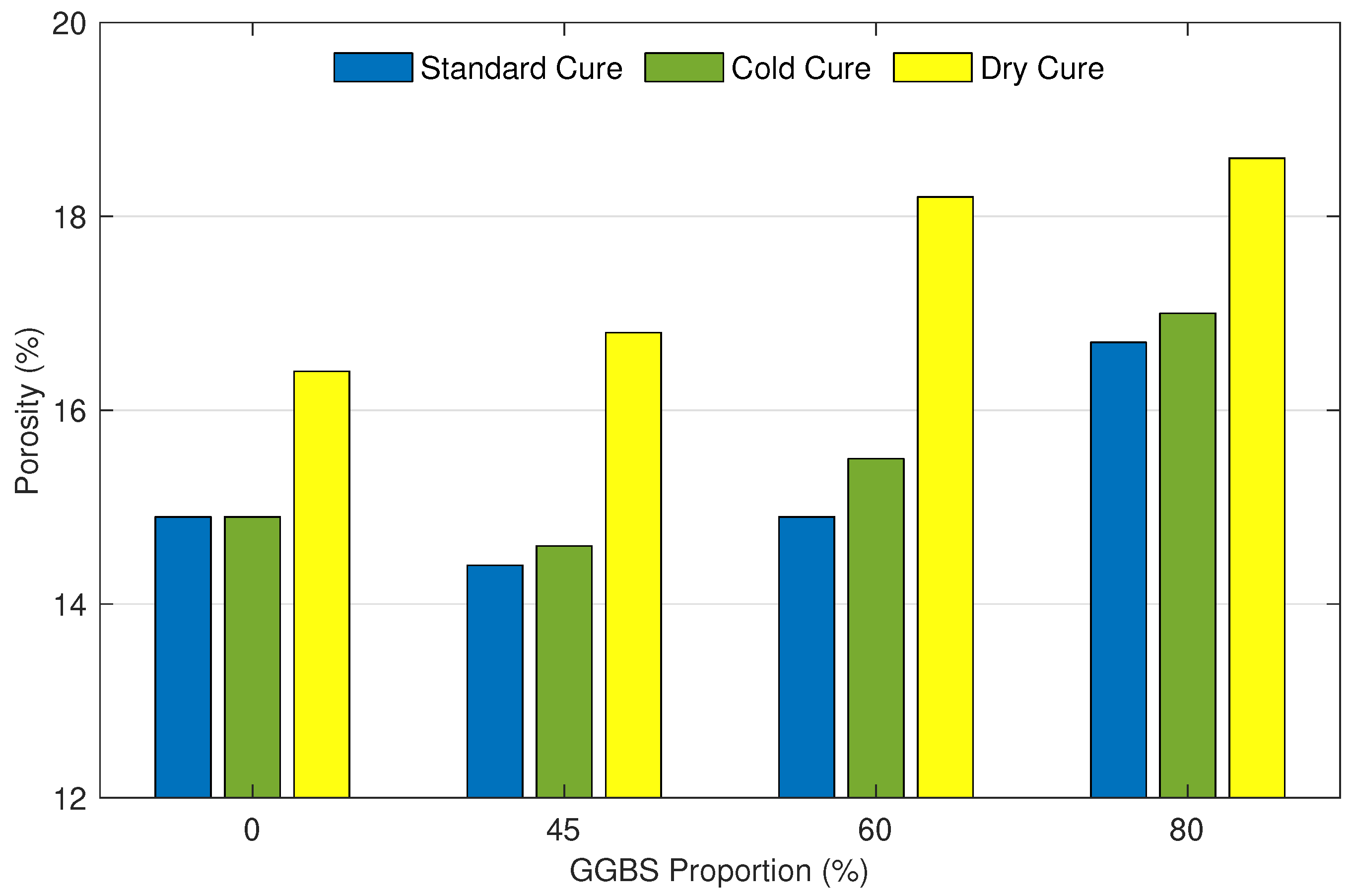
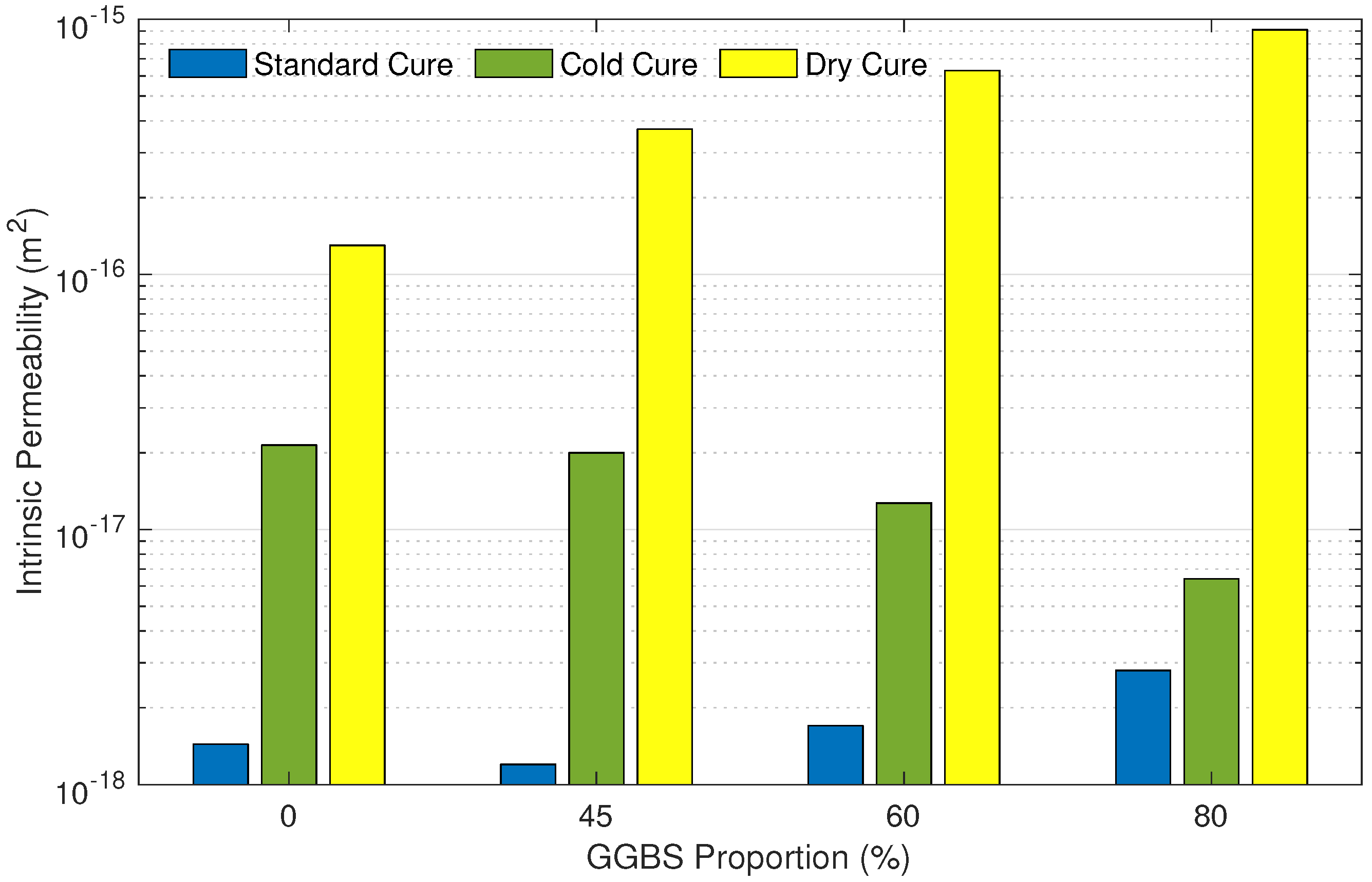
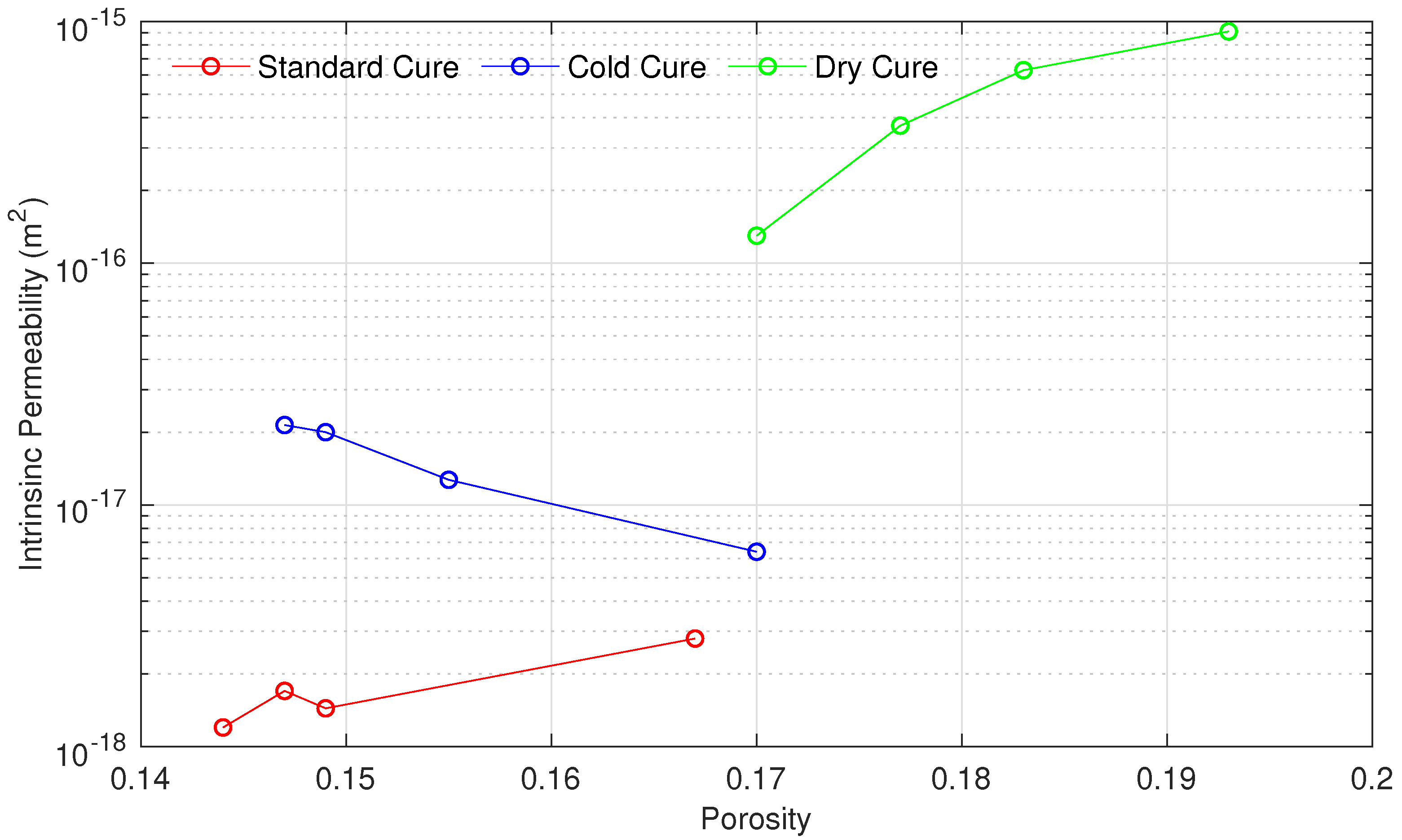
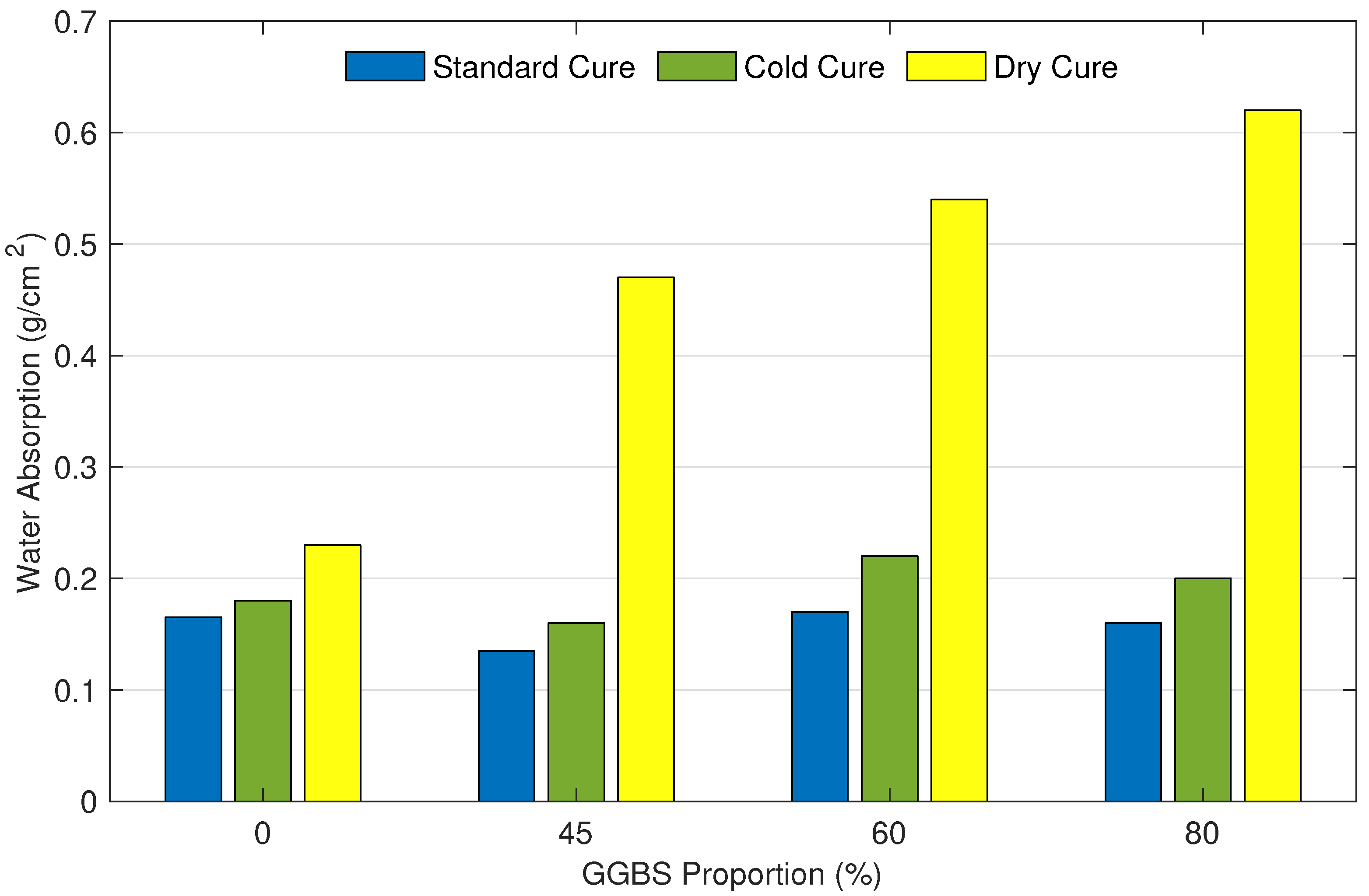
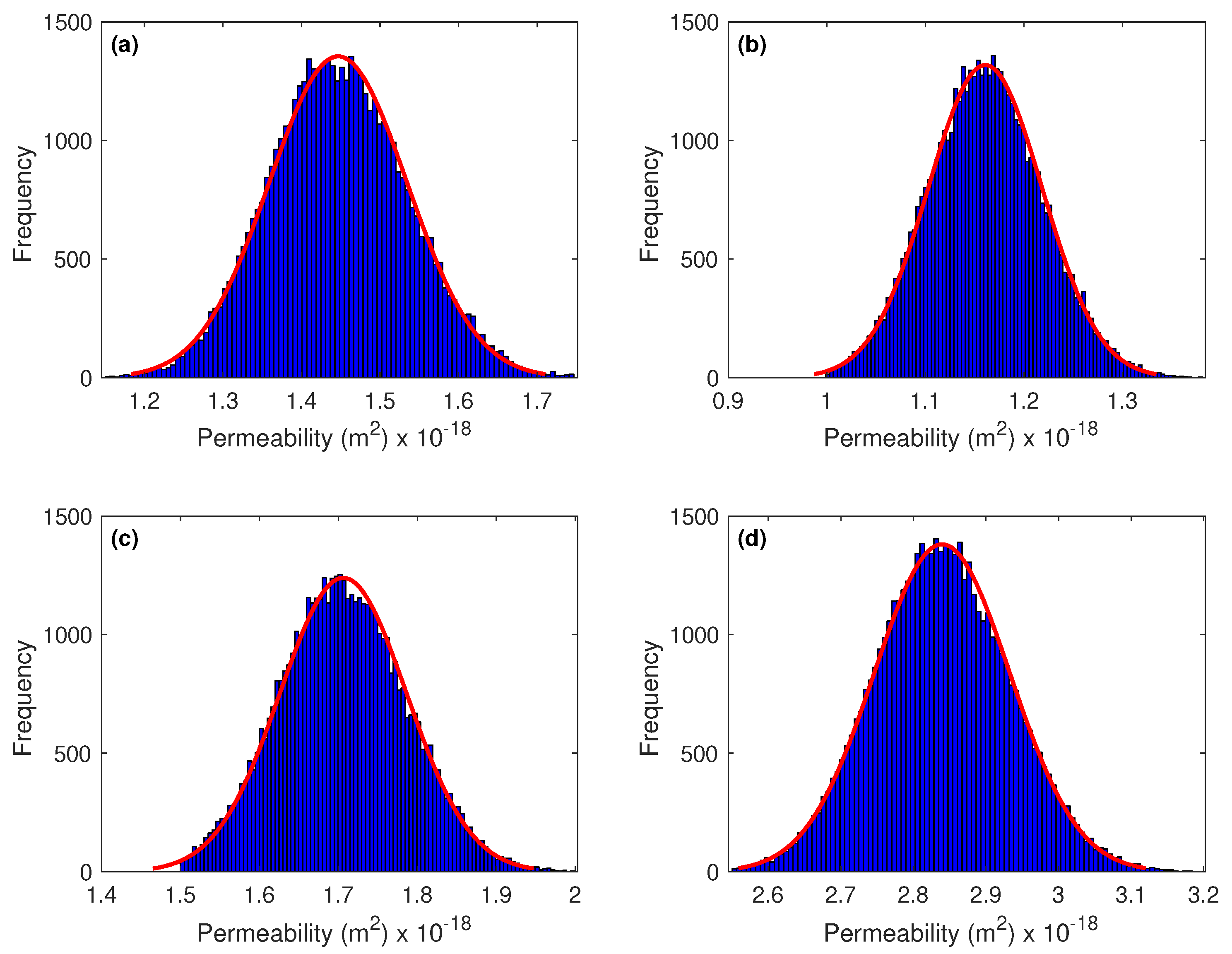
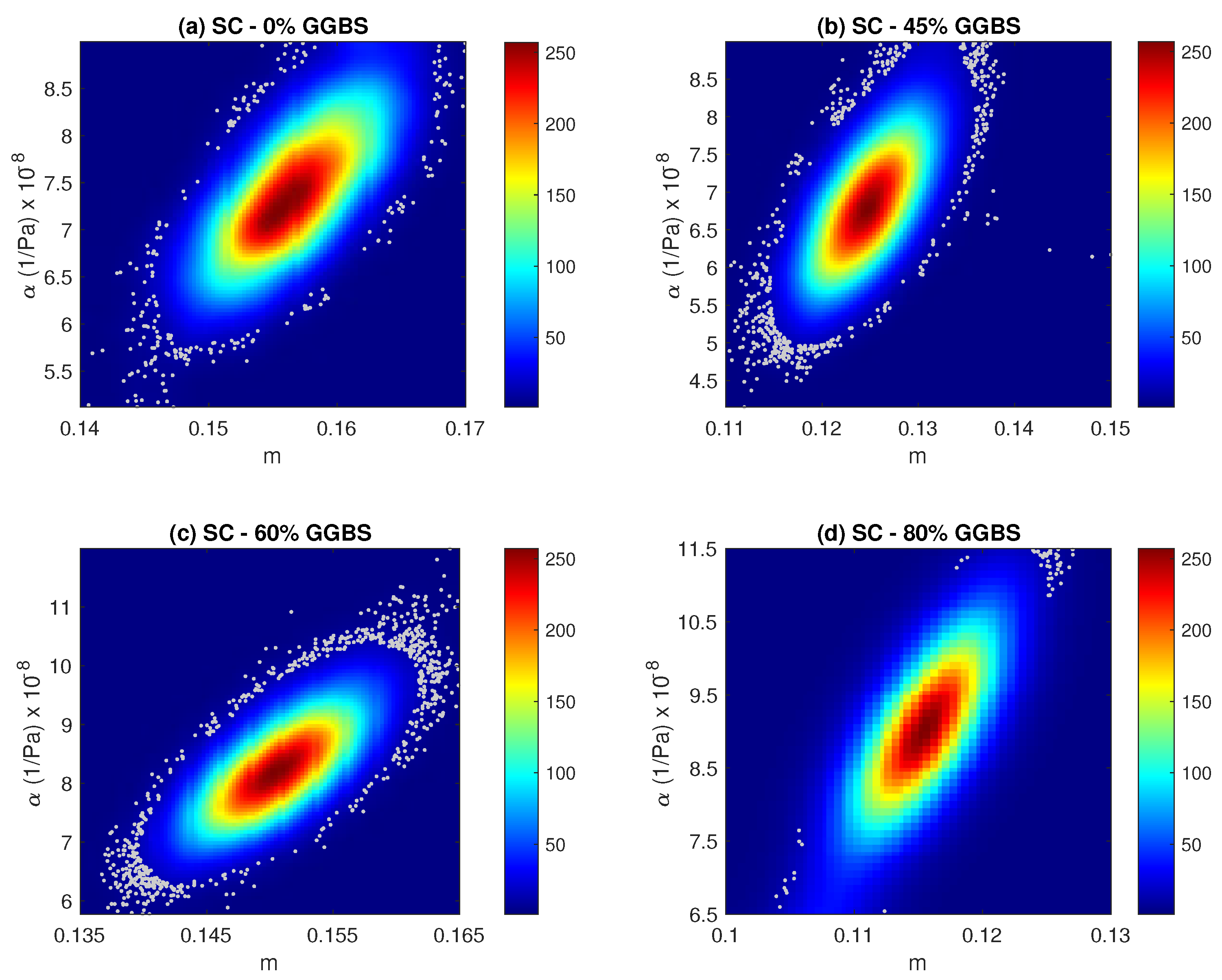
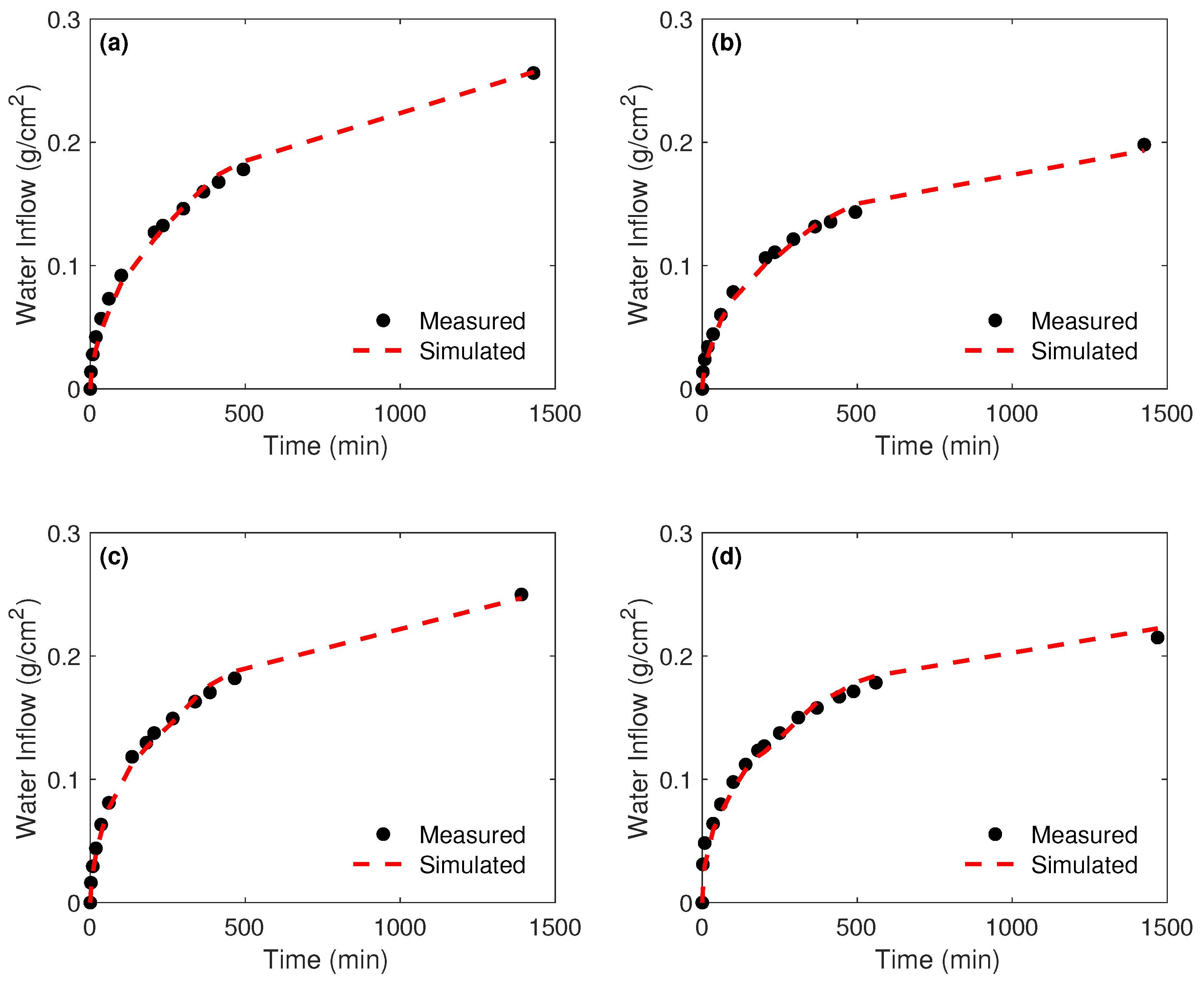
| Material | SiO | AlO | FeO | CaO | NaO | KO | MgO | SO |
|---|---|---|---|---|---|---|---|---|
| CEM I 52.5 N | 20.1 | 4.8 | 3.4 | 63.6 | 0.1 | 1.0 | 1.3 | 3.1 |
| GGBS | 36.2 | 11.5 | 0.3 | 41.3 | 0.1 | 0.4 | 7.3 | 3.7 |
| Mix | Cement (kg/m) | GGBS (kg/m) | Water (kg/m) | Sand (kg/m) | w/c |
|---|---|---|---|---|---|
| CEM-GGBS 0% | 450 | 0 | 202.5 | 1350 | 0.45 |
| CEM-GGBS 45% | 247.5 | 202.5 | 202.5 | 1350 | 0.45 |
| CEM-GGBS 60% | 180 | 270 | 202.5 | 1350 | 0.45 |
| CEM-GGBS 80% | 90 | 360 | 202.5 | 1350 | 0.45 |
| Sample | m | m | Pa | m | |
|---|---|---|---|---|---|
| Experimental | Numerical | ||||
| CEM-GGBS 0% | 1.44 | 1.45 | 7.19 | 0.156 | 6.4 |
| CEM-GGBS 45% | 1.20 | 1.16 | 6.79 | 0.125 | 5.3 |
| CEM-GGBS 60% | 1.70 | 1.71 | 8.17 | 0.150 | 4.9 |
| CEM-GGBS 80% | 2.80 | 2.84 | 9.02 | 0.116 | 8.5 |
Publisher’s Note: MDPI stays neutral with regard to jurisdictional claims in published maps and institutional affiliations. |
© 2022 by the authors. Licensee MDPI, Basel, Switzerland. This article is an open access article distributed under the terms and conditions of the Creative Commons Attribution (CC BY) license (https://creativecommons.org/licenses/by/4.0/).
Share and Cite
Ghostine, R.; Bur, N.; Feugeas, F.; Hoteit, I. Curing Effect on Durability of Cement Mortar with GGBS: Experimental and Numerical Study. Materials 2022, 15, 4394. https://doi.org/10.3390/ma15134394
Ghostine R, Bur N, Feugeas F, Hoteit I. Curing Effect on Durability of Cement Mortar with GGBS: Experimental and Numerical Study. Materials. 2022; 15(13):4394. https://doi.org/10.3390/ma15134394
Chicago/Turabian StyleGhostine, Rabih, Nicolas Bur, Françoise Feugeas, and Ibrahim Hoteit. 2022. "Curing Effect on Durability of Cement Mortar with GGBS: Experimental and Numerical Study" Materials 15, no. 13: 4394. https://doi.org/10.3390/ma15134394
APA StyleGhostine, R., Bur, N., Feugeas, F., & Hoteit, I. (2022). Curing Effect on Durability of Cement Mortar with GGBS: Experimental and Numerical Study. Materials, 15(13), 4394. https://doi.org/10.3390/ma15134394







